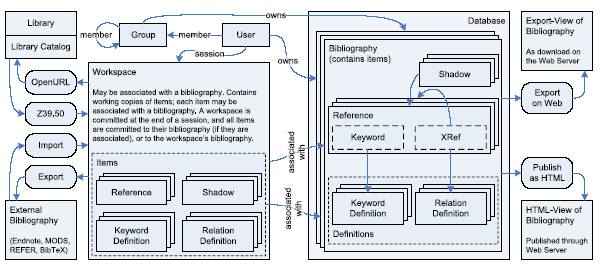ShaRef |

|
 Diese Seite wurde seit 10 Jahren inhaltlich nicht mehr aktualisiert.
Unter Umständen ist sie nicht mehr aktuell.
Diese Seite wurde seit 10 Jahren inhaltlich nicht mehr aktualisiert.
Unter Umständen ist sie nicht mehr aktuell.
 BiblioMap
BiblioMap 
 Definitionen
Definitionen
 While traditional Libraries often concentrate on the repository and retrieval facets of their work, for many scientists it is also very important to be able to manage and maintain references to the information they work with, such as bibliographic information and Web bookmarks. ShaRef aims at providing a solution (usable Web-based as well as offline) for creating, managing, and sharing reference information. This information can be exported to other applications (such as word processing software or Web browsers). ShaRef is based on XML technologies for providing an open platform with powerful importing and exporting features. Web-based publishing features allow Web access and the creation of selected reference lists such as reading lists for lectures and seminars or publication lists for specific research areas.
While traditional Libraries often concentrate on the repository and retrieval facets of their work, for many scientists it is also very important to be able to manage and maintain references to the information they work with, such as bibliographic information and Web bookmarks. ShaRef aims at providing a solution (usable Web-based as well as offline) for creating, managing, and sharing reference information. This information can be exported to other applications (such as word processing software or Web browsers). ShaRef is based on XML technologies for providing an open platform with powerful importing and exporting features. Web-based publishing features allow Web access and the creation of selected reference lists such as reading lists for lectures and seminars or publication lists for specific research areas. Source: http://dret.net/projects/sharef/
 Bemerkungen
Bemerkungen
 It is important to note that ShaRef is not meant as a library-scale tool, which means that bibliographies in ShaRef are not meant to have hundreds of thousands of even millions of entries. Instead, it is meant as a personal bibliography management tool with sharing capabilities, so that individuals (with hundreds and maybe thousands of entries) can share and/or combine their information to access bibliographic entries in the magnitude of tens of thousands.
It is important to note that ShaRef is not meant as a library-scale tool, which means that bibliographies in ShaRef are not meant to have hundreds of thousands of even millions of entries. Instead, it is meant as a personal bibliography management tool with sharing capabilities, so that individuals (with hundreds and maybe thousands of entries) can share and/or combine their information to access bibliographic entries in the magnitude of tens of thousands. ShaRef is based on XML technologies and the data model is defined as an XML Schema. It is thus easily possible to add new fields to ShaRef records, which are handled transparently in ShaRef. Openness means that ShaRef will accept unknown XML structures (where they are allowed) and handle them transparently, so that they will be exported from ShaRef in the same way as they have been imported. For example, a user adding sophisticated XML-based descriptions of resources to references using a selfdefined field type will be able to retrieve this field together with the reference unaltered. Thus, ShaRef can be used to store data that it cannot interpret.
ShaRef is based on XML technologies and the data model is defined as an XML Schema. It is thus easily possible to add new fields to ShaRef records, which are handled transparently in ShaRef. Openness means that ShaRef will accept unknown XML structures (where they are allowed) and handle them transparently, so that they will be exported from ShaRef in the same way as they have been imported. For example, a user adding sophisticated XML-based descriptions of resources to references using a selfdefined field type will be able to retrieve this field together with the reference unaltered. Thus, ShaRef can be used to store data that it cannot interpret. Verwandte Objeke
Verwandte Objeke
 Verwandte Begriffe (co-word occurance) |
 Relevante Personen
Relevante Personen
 Häufig erwähnende Personen
Häufig erwähnende Personen
 Häufig co-zitierte Personen
Häufig co-zitierte Personen
 Statistisches Begriffsnetz
Statistisches Begriffsnetz 
 Zitationsgraph
Zitationsgraph
 Zitationsgraph (Beta-Test mit vis.js)
Zitationsgraph (Beta-Test mit vis.js)
 6 Erwähnungen
6 Erwähnungen 
- Knowledge Organization Mashups (Erik Wilde)


- Usage and Management of Collections of References - Technical Report TIK Report No. 194 (Erik Wilde) (2004)


- References as Knowledge Management (Erik Wilde) (2004)


- ShaRef: XML-Centric Software Design - Technical Report TIK Report No. 213 (Sai Anand, Erik Wilde, Petra Zimmermann) (2005)


- Shared Bibliographies as Hypertext - Technical Report TIK Report No. 224 (Erik Wilde) (2005)


- ICT-Strategie der ETH Zürich (Massnahmen) (2006)


 Externe Links
Externe Links
 ShaRef: Project Hoimepage ( ShaRef: Project Hoimepage (  : :  2021-03-20) 2021-03-20) |










 Biblionetz-History
Biblionetz-History